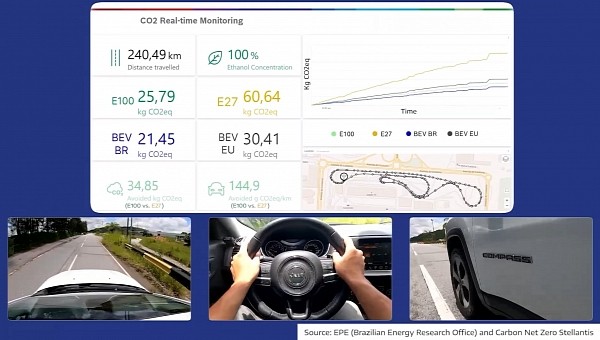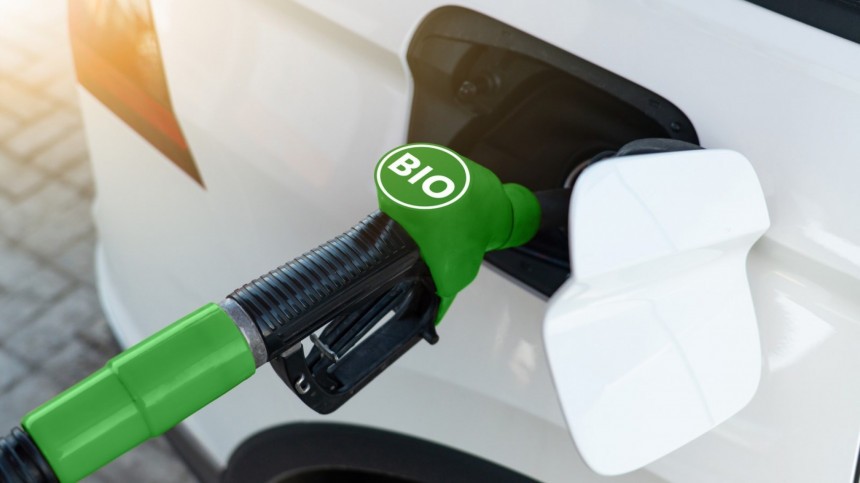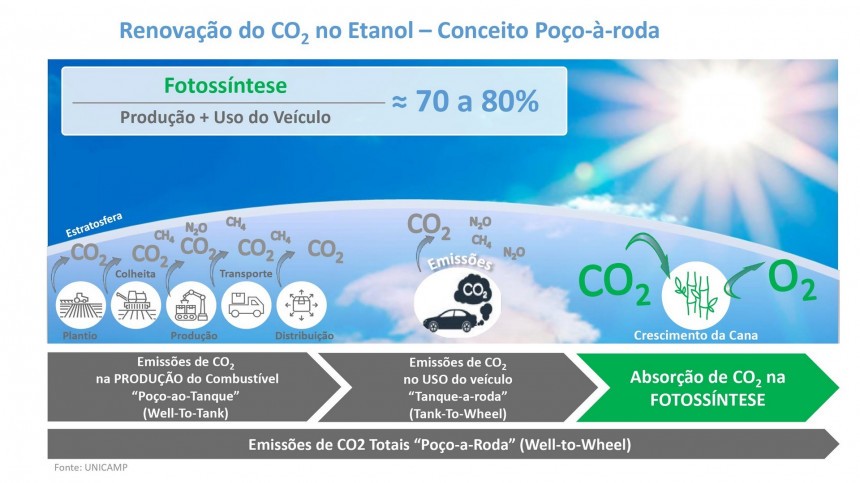Climate change concerns have created a massive distortion when it comes to vehicle emissions. To a large extent, this distortion is what gave birth to Dieselgate. Concerned with carbon, American and European regulators failed to question how Volkswagen managed to comply with nitrogen oxide emissions. Stellantis showed the priority might create new distortions when it said ethanol is cleaner than EVs charged in Europe.
The automaker said it used a Bosch methodology that measures well-to-wheel emissions in different scenarios. Stellantis did not reveal the parameters it added to each simulation it performed. It just shared a video of a Jeep Compass running tests at the Stellantis track in Betim, Brazil. The SUV was apparently fueled with pure ethanol (E100), but here we may get the first flaw with the evaluation.
Apart from ethanol, Stellantis also calculated emissions from an EV charged with the Brazilian electricity mix, one charged with the European energy mix, and Brazilian gasoline – called E27 because it contains 27% of the renewable fuel. As you know, the Jeep Compass does not have a BEV derivative that could be compared to the one with a flex-fuel engine. It only has a plug-in hybrid version, which is much lighter than a BEV would be. How Stellantis and Bosch managed to simulate credible comparison parameters to support their findings is something neither shared. I asked the automaker to clarify that and will write a new article with its answers.
The Jeep Compass ran 240.49 kilometers (149.43 miles) at the Betim test track, and the video shows the results obtained with this evaluation. It also reveals that Stellantis used data from EPE (Empresa de Pesquisa Energética, or the Brazilian Energy Research Office) and Carbon Net Zero Stellantis, possibly to have the emissions associated with electricity production in each location.
The Bosch methodology revealed that the Compass emitted 25.79 kg (57 lb) of carbon with ethanol. Suppose the hypothetical scenarios in which the Jeep would have used other energy sources. In that case, it would have emitted 60.64 kilograms (134 lb) of carbon with gasoline, the equivalent of 30.41 kg (67 lb) if it were an electric car charged with the European energy matrix, and 21.45 kg (47 lb) if such a fictitious BEV used the Brazilian energy mix.
Stellantis stressed that sugarcane “absorbs 70% to 80% of CO2 released in the production and burning of ethanol.” However, it is not clear if the emissions figures with ethanol took that into consideration. If that was the case, these 25.79 kg (57 lb) are not the total amount of carbon the Compass emitted: they are just a fraction – 20% or 30%. If Stellantis just disclosed the total carbon emissions, we could argue that a car powered by the renewable fuel is even cleaner than this number suggests.
The reason for that is simple. As I already explained in my article about how shallow the discussion about banning internal combustion engines currently is, most people have no idea what the greenhouse effect is. Those who get it know the issue is not the effect per se: it is making it worse by adding more carbon and other greenhouse gases (GHG) to the atmosphere. If sugarcane absorbs 70% to 80% of the carbon it needs from the atmosphere, burning ethanol just puts carbon back where it was. Better saying, it did not add this carbon to the atmosphere after it was stored for millions of years as a fossil fuel.
Based on these numbers provided by Stellantis, we see that the Compass emits 252.15 g/km with E27, 126.45 g/km with European electricity, 107.24 g/km with E100 (theoretically), and 89.19 g/km with energy made in Brazil – which comes mostly from hydroelectric power plants, but also from gas-fired power plants. For the automaker, that means that a combustion-engined vehicle running on pure ethanol is cleaner than an EV used in Europe. In fact, it may be even cleaner than that when it relates to carbon emissions.
If 70% of ethanol emissions correspond to what was already in the atmosphere and Stellantis released the gross carbon emissions the Compass on E100 presented, the accurate CO2 released by the Jeep would be 7.74 kg (17 lb) – or 30% of the 25.79 kg (57 lb) Stellantis informed. That said, the SUV powered by the renewable fuel would actually emit 32.18 g/km, making it even cleaner than an EV charged under the Brazilian energy mix.
As incredible as that may seem – and supposing all numbers are right – that would only be correct when we consider carbon emissions. What about nitrogen oxides, hydrocarbons, ozone, particulates, and several other pollutants produced by combustion engines? Stellantis did not disclose these emissions, but I asked the company about them. Even if the automaker is not able to share them with me, it is clear that an electric vehicle will not deliver any of these pollutants. It may even do that indirectly – due to gas-fired power plants – but it seems nobody cares about them. Or have you ever seen an NMHC or NOx equivalent when people talked about emissions? There you have it.
While all worries are related to carbon dioxide, renewable fuels will still have a place in personal mobility without substantial changes to the model we currently follow. Combustion engines may still be an option if they burn renewable fuel, synthetic or not. This is the point Stellantis tried to make. In a world where only carbon matters, it probably succeeded in doing so.
Apart from ethanol, Stellantis also calculated emissions from an EV charged with the Brazilian electricity mix, one charged with the European energy mix, and Brazilian gasoline – called E27 because it contains 27% of the renewable fuel. As you know, the Jeep Compass does not have a BEV derivative that could be compared to the one with a flex-fuel engine. It only has a plug-in hybrid version, which is much lighter than a BEV would be. How Stellantis and Bosch managed to simulate credible comparison parameters to support their findings is something neither shared. I asked the automaker to clarify that and will write a new article with its answers.
The Bosch methodology revealed that the Compass emitted 25.79 kg (57 lb) of carbon with ethanol. Suppose the hypothetical scenarios in which the Jeep would have used other energy sources. In that case, it would have emitted 60.64 kilograms (134 lb) of carbon with gasoline, the equivalent of 30.41 kg (67 lb) if it were an electric car charged with the European energy matrix, and 21.45 kg (47 lb) if such a fictitious BEV used the Brazilian energy mix.
The reason for that is simple. As I already explained in my article about how shallow the discussion about banning internal combustion engines currently is, most people have no idea what the greenhouse effect is. Those who get it know the issue is not the effect per se: it is making it worse by adding more carbon and other greenhouse gases (GHG) to the atmosphere. If sugarcane absorbs 70% to 80% of the carbon it needs from the atmosphere, burning ethanol just puts carbon back where it was. Better saying, it did not add this carbon to the atmosphere after it was stored for millions of years as a fossil fuel.
If 70% of ethanol emissions correspond to what was already in the atmosphere and Stellantis released the gross carbon emissions the Compass on E100 presented, the accurate CO2 released by the Jeep would be 7.74 kg (17 lb) – or 30% of the 25.79 kg (57 lb) Stellantis informed. That said, the SUV powered by the renewable fuel would actually emit 32.18 g/km, making it even cleaner than an EV charged under the Brazilian energy mix.
While all worries are related to carbon dioxide, renewable fuels will still have a place in personal mobility without substantial changes to the model we currently follow. Combustion engines may still be an option if they burn renewable fuel, synthetic or not. This is the point Stellantis tried to make. In a world where only carbon matters, it probably succeeded in doing so.






























